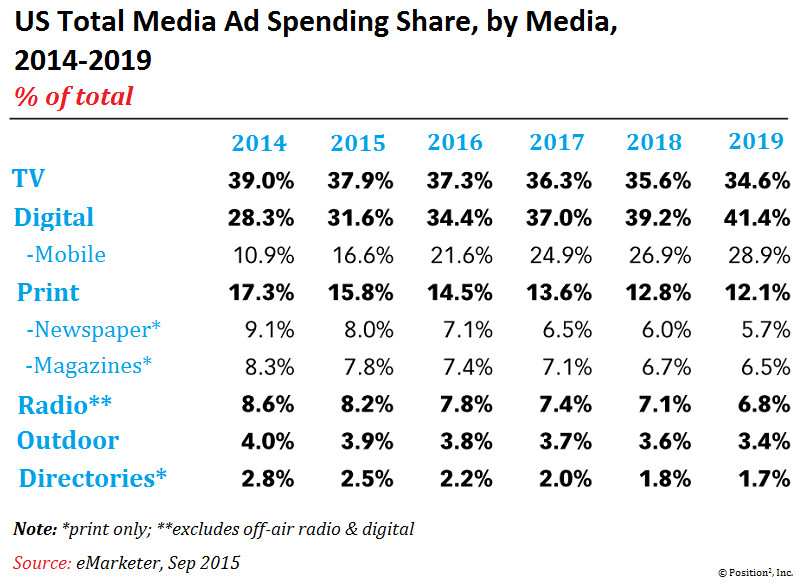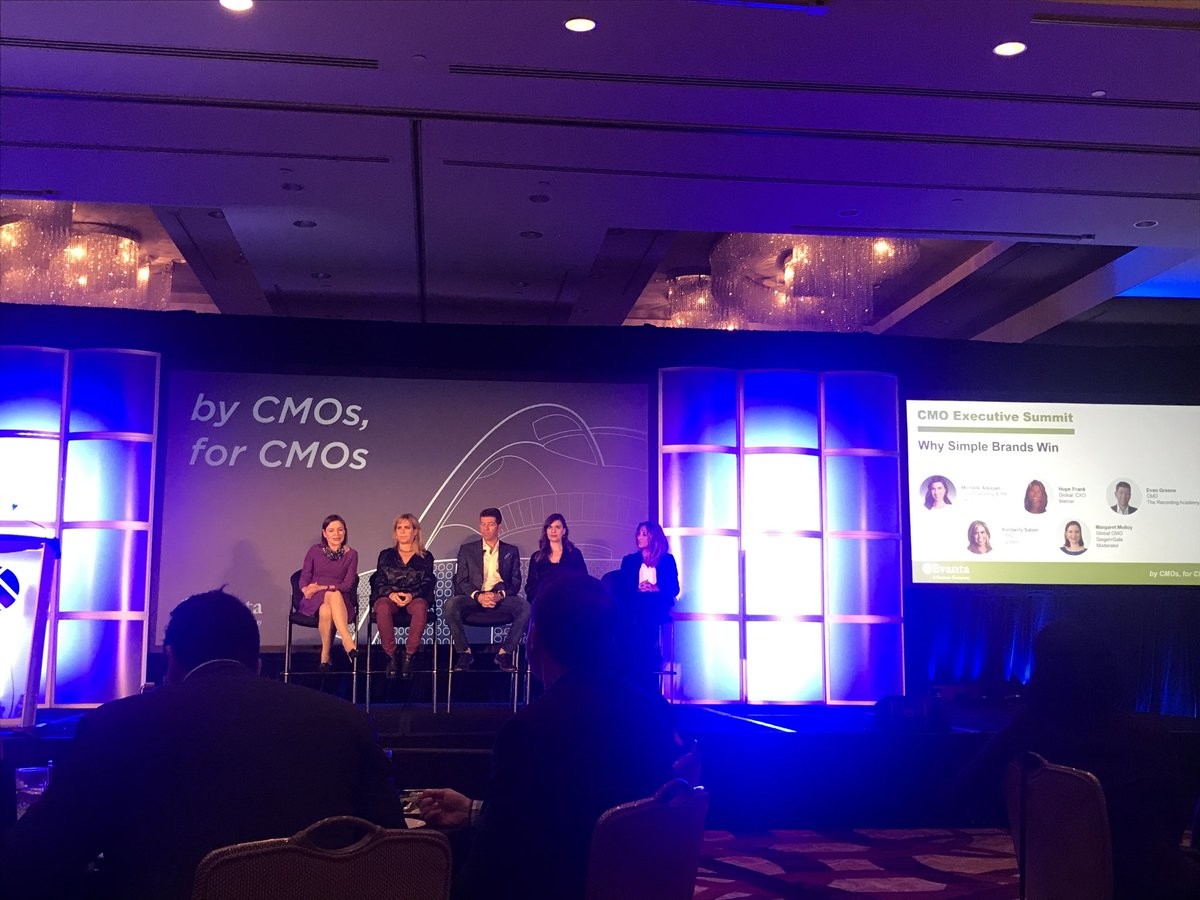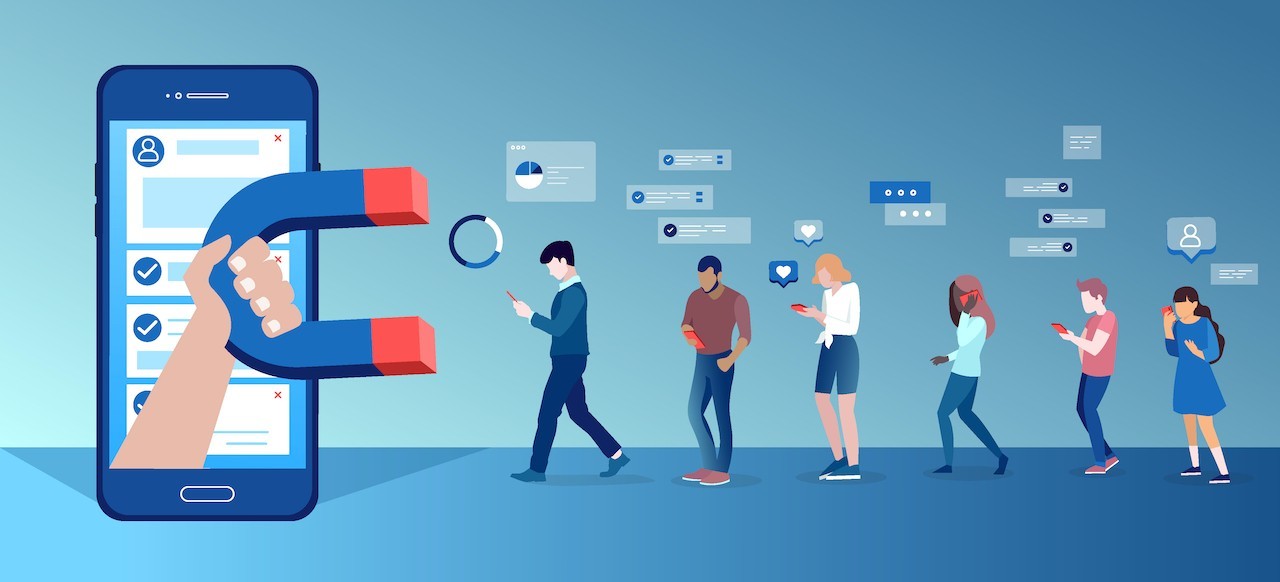Ready to learn Marketing & Customer Analytics Training? Browse courses like Increase Cross Selling and Upselling of Products and Services developed by industry thought leaders and Experfy in Harvard Innovation Lab.
Marketing is the most data intensive line of business in any organization with goals of ambitious scale. Now, we can very effectively talk about ad-effectiveness and measurement, and the mathematics of click through rates and sales lift resulting in digital campaigns. However, the moral of this story is not about correlations and testing experiments, it's about the importance of an organization's data story, and how businesses should have an aligned data strategy throughout their leadership team to leverage the power of innovation and disruption as the world digitizes.
It's obvious to most people that current and future ad spend will be concentrated around the digital space, with mobile ad spending projected to increase by a CAGR of 21.53% (most of us are probably reading this from our mobile devices as we speak). According to eMarketer, ALL other ad spending mediums are in the decline. If the very essence of digital marketing is a mastery of data, than CMOs need to be thinking about what is going on in IT, and vice versa.
Tragedy #1: The CMO & CIO Conundrum
Gartner predicts that in 2017, marketing leaders will spend more than CIOs do on technology. Close to 90% of marketing leaders report oversight of capital budgets, of which they allocate 33% toward technology infrastructure. Of that, 10% drives marketing innovation, including tools to improve digital commerce – gartner.com/marketing
The genesis for most of this conversation began with my conversations with CIOs and their mission for their businesses to become data driven businesses. Recently, I attended the US CMO Digital Summit hosted by GDS Group, a technology services business focused on helping customers solve challenges in a disruptive business environment. As a representative of the Microsoft's Data & AI solution area, I spoke to more than 20 CMOs of the country's top retail organizations. Greater than 30% of the conversations focused on a common theme: "We are very behind, I don't know where our data sits, and even if I did, we wouldn't have a good understanding of it". This was a profound theme I noticed, and from here the conversation quickly transformed into a "technology therapy" session, where I listened to subtle frustrations about the CIO relationship. Beyond being a shoulder to cry on, I provided the following inspiration:
Producing a simple work flow of the foundation of what an organizations data strategy could look like, and sharing with each marketing leader, was extremely helpful. Rather than focusing on an ethereal "where is your data and what are you doing with it"conversation, we worked together to map out the common process of deriving data from multiple sources, all the way to the packaged intelligence it could offer in a series of outlets including visualizations (Power BI and Tableau), automated processes, and even data for chat bots.
I was most surprised to learn that data ingestion and big data storage were the most foreign to marketing leaders, while advanced analytics (including machine learning and AI) and business intelligence were the most sexiest and in need of being understood. Understanding where each team sat in the organizations data story, was incredibly powerful, and seemed to inspire the accountability and permission for business leaders to engage in a more informed and strategic technology conversation with IT.
CIOs and CMOs must share each others mindset in how data plays a part in the organizations business strategy, and if this isn't the case, both will end up overspending and over allocating budget and talent in the quest to "be an analytical organization". Here are some items for marketing leaders to explore if all of this sounds familiar:
- Understand the importance of IT (after all, they keep the hackers out).
- Develop a defined problem statement: data and AI is just a means to an end, what problem are you trying to solve? Can you briefly communicate these needs to the CIO?
- Help IT understand the importance of your mission and how it will help the organization. Spend time communicating use cases and problem statements as necessary.
- If all else fails, find a technology partner. You have the full authority to introduce good technology to IT, or run with it under your own P & L.
Tragedy #2: Strengthening Brand…What About Engagement?
"There's more content being created now in 24 hours, than there was in the decades of the 50's and 60's…wrap your head around what the f*ck is actually happening now!?" – Gary Vaynerchuk, CEO of VaynerMedia
A Keynote:Session 2 of Copenhagen Elevate 2017, The GaryVee Audio Experience
I recently attended a CMO event that Evanta (A Gartner company), hosted at the LA Hotel in Downtown Los Angeles. Microsoft and Oracle Cloud Marketing, amongst others, were sponsors. One of the most interesting things I noticed, was the topic of the panel discussion during lunch: "Why Simple Brands Win". Although the folks up on stage had some very good things to share, I couldn't help but to conduct a very detailed and granular analysis of the table cloth, carpet design, and chandeliers up above me (there was some great lighting in that ballroom). I was bored out of my wits. Picture compliments of @cbhibbs.
Not only did I feel like I was sitting in the 3rd row of a typical marketing class in 1992, but I just didn't understand why we weren't talking about how to compete for attention, at the epoch of the digital era, using multi-medium content on multi-social platforms that scale across every level of potential customer engagement. This is the ONLY conversation that CMOs should really care about right now.
If you care about digital marketing, and why every business is a media company first, then you should check out Gary Vaynerchuk's podcast (be warned, he's got a potty mouth).
CMOs should care about HOW customers are engaging and consuming on a multi-device scale (smartphone vs tablet vs notebook), and the type of information that is consumed at a demographic level. Adobe Analytics' survey above, addresses the significant difference in sharing intensity on Facebook for media and entertainment versus other forms of web traffic.
Other numbers in the write-up convey a market share decline in devices with larger screens, and also adds color to age: "More than half of consumers under the age of 35 said they get the majority of their news via social media as opposed to TV, news platforms, or newspapers. However, less than 25% of consumers over 35 indicated the same."
Does all this sound important? The prevalence of intense social media analytics should be a driving force in the battle for consumer attention, and incumbents that embrace the ultimate importance of the device on their desks, in their front pocket, or in their purse, will stand a far better chance at not being absolutely crushed.
The question is, where does the importance of brand fit into this? As all of us continue to compete for attention, how do we drive home through marketing leadership, that ultimately all of our lives are (or will be) completely driven by that little device in our hands. Whether we like it or not, focusing on how customers will consume, and how human beings engage with technology are far more important questions for brand management.
Tragedy #3: Finding the Right Kinds of Nerds: Human and Machine
People are now really focused on ensuring that the engagement that they have with customers, whether that be through the Internet of devices, whether that be through digital screens and retail stores, whether that be through autonomous cars, is a personalizing for age – Shantanu Narayen, CEO of Adobe
"Nightly Business Report", December 15th, 2017
So now we know that the marketing conversation, is really a technology conversation, that needs to be a data conversation. How can marketing leaders move forward with business strategies that are centered around the power of data? It focuses on two major things: lack of tools, and lack of talent.
While talking to CMOs at the conferences I have been attending in the last several weeks, the consistent answer to my question, "what has kept you up at night this year?", can really be distilled down to tools and talent, and how these integrate together for a holistic analytics experience throughout the organization's outreach efforts.
Hiring 3rd party media businesses to drive analytics in your organization as a solution, can not be part of the winning strategy. Businesses require domain specific talent that is developed in house to integrate with your organizations mission, initiatives, and proprietary business functions, as part of a forward looking human-capital investment strategy. If we look at the rise of new roles in the marketing arena, namely Adtech and Martech (which are meant to speak to the importance of this write-up), and the importance of data and AI to marketing analytics, it is easy to understand that:
This is where it starts getting fun. Businesses need to start thinking about where and how they are analyzing data feeds from the market, monitoring customer behavior from social media marketing campaigns and then using the data to assess the following:
- Addressing campaign gaps through predictive modeling: This could look like analyzing content engagement data on Twitter, Instagram, and Facebook overtime, correlating with proprietary and 3rd party data sets such as weather, equity markets, and competitive campaigns ran at the same time, to discern why content may have failed and how to engineer to be more effective to the correct audience the next time.
- Lead management through analytics: national marketing campaigns pick up troves of leads, but tracking these leads throughout the sales process and learning from how they interact on websites, apps, and social media, and beyond in the post purchase lifecycle, will allow brands to be more intelligent in how they customize their message and further understand how their customers are changing.
- Customer engagement and satisfaction throughout the sales process: bolting on the intelligence from lead management, will also allow the business to be smarter on the customer before they buy again in the future. In the example of a car dealership, understanding how the customer has been consuming content on social media, engaging with the dealer website, and responding to past marketing campaigns, will equip the business with the product/services bundles that will best suit the needs of the customer with the largest propensity to buy. Examples could include: how often do they drive, where do they drive, and what is the opportunity for tire sales or new lease contracts based on their customer journey.
- AI opportunities with image recognition and chat bots: The more data businesses accumulate, the richer they will become. Cognitive services such as image and speech recognition can analyze real time video feed (from social media or store fronts) to measure the impact and customer reaction of product displays and media campaigns, discerning how likely customers are to buy. Chat bots can utilize historical and real time data to ascertain likelihood to churn, and to make offers of discounts or product bundles based on customer sentiment scoring. Responses from all of these actions of course, help the algorithms learn how to be even more effective as more data is gathered.
Hopefully after reading this you are inspired, afraid, excited, and in denial – I was too on these topics until I really started paying attention. Data is the new currency, every business will become a data business. We are all competing for attention.
Every line of business must learn how to utilize technology to derive intelligence, execute with automation, and lead with action in the pursuit of value.








